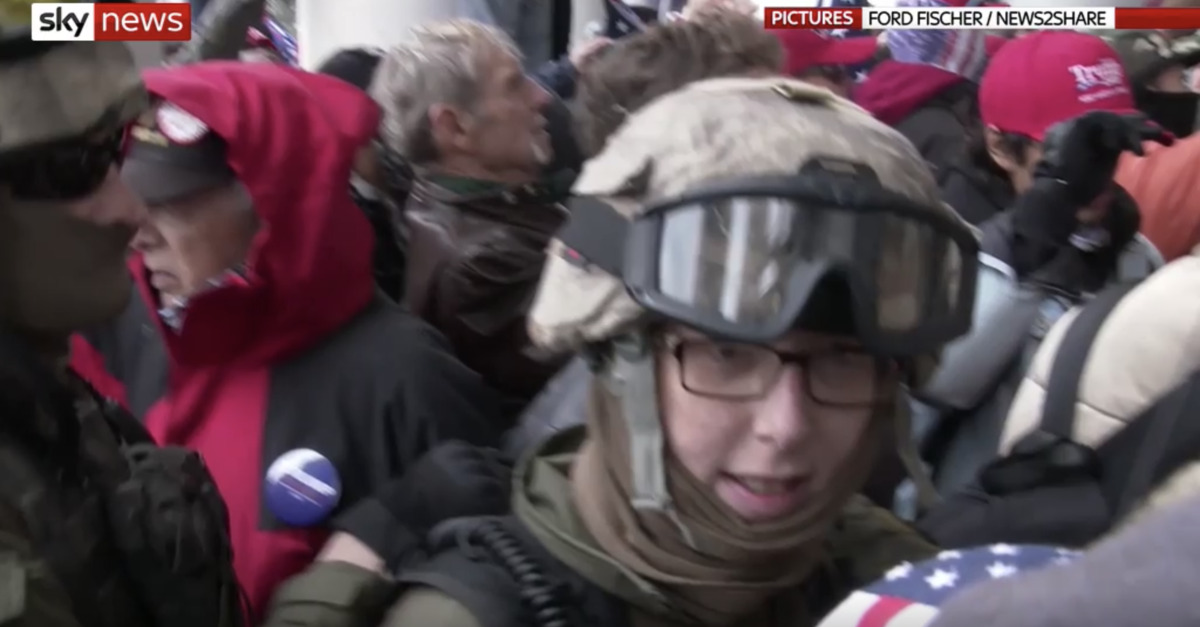
An alleged Capitol Hill rioter and far-right militia movement member is set to be hoist by her own petard, the government hopes.
In a Thursday pre-trial detention memorandum for Oath Keeper Jessica Watkins, prosecutors cited alleged internal “operational plans” in an effort to keep her behind bars prior to an upcoming trial on myriad charges including conspiracy against the United States.
“Watkins’s premediated and coordinated conduct created an unprecedented danger, the effects of which continue to reverberate throughout this city and nation—and which demonstrate that there are no conditions of release that can reasonably assure the safety of the community,” the D.C. U.S. Attorney’s Office argues in the 21-page memo. “[The] Court should thus detain Watkins pending trial.”
“Watkins traveled to Washington D.C. and ‘forced entry into the Capitol building’ because of her professed belief that the newly-elected government is illegitimate,” the memo continues. “Moreover, as evidenced by her conduct leading up to, during, and after the attack on the Capitol, Watkins exhibited a single-minded devotion to obstruct through violence an official proceeding that, on January 6, was designed to confirm the next President of the United States. Crimes of this magnitude, committed with such zeal, belie any conditions of release that would reasonably assure the safety of the community or by which Watkins could be trusted to abide.”
The 38-year-old Ohio resident was initially arrested and charged in late January with multiple federal crimes via criminal complaint. A secondary complaint implicated her, 65-year-old Thomas E. Caldwell and 50-year-old Donovan Crowl in conspiracy and added additional charges that carry a statutory maximum of 42.5 years in prison—though such lengthy sentences are highly unlikely.
In the detention memo, prosecutors hone in on what they claim are a series of unearthed text messages between Watkins and Caldwell which allegedly “contemplated the possession and use of weapons in D.C. before and on January 6.”
From the government’s memo:
Caldwell referenced “a quick reaction force [QRF] [that would be] bringing the tools if something goes to hell. That way the boys don’t have to try to schelp [sic] weps on the bus.” Watkins previously stated that the QRF provided ready access to guns during operations. As she explained to a contact when preparing to attend a November election fraud rally in Washington D.C., QRF was designed so that “If it gets bad, they QRF to us with weapons for us,” but that, otherwise, “[w]e can have mace, tasers, or night sticks. QRF staged, armed, with our weapons, outside the city” and advised “to be prepared to fight hand to hand” while “guys outside DC with guns, await[] orders to enter DC under permission from Trump, not a minute sooner.” Watkins’s own operational role extended well beyond providing medical aid. As she explained to a recruit, “I’m no doctor. I’m a soldier. A medic with a rifle, maybe, but a solider. I will hurt/kill those who try to hurt/kill me or others.”
But, initially, the memo notes, Watkins was reticent about signing off on the use of any weapons at all—believing that the Oath Keepers and other pro-Donald Trump forces would be able to count on law enforcement to be friendly toward white supremacist and paramilitary movements.
“Watkins coordinated with two other Ohio residents about traveling with them to Washington, D.C. on January 4, 2021, as well as notifying them about directives she received that ‘We are not bringing firearms. QRF will be our Law Enforcement members of Oathkeepers,'” the memo alleges. (QRF means “Quick Reaction Force.”)
Hours later, however, Watkins apparently had a change of heart.
“Weapons are ok now as well,” she allegedly messaged an unidentified Oath Keeper. “Sorry for the confusion.”
Those weapons did not include guns—which courts throughout the prosecutions of various alleged Capitol insurrections have keenly inquired about when presented with prosecutorial claims of an individual’s propensity for or capability of violence—but the government says the lack of guns here isn’t entirely dispositive.
Again, the memo:
Even if it is true that Watkins did not carry firearms with her into the Capitol, she also did not feel the need given the Quick Reaction Force (QRF) presence nearby “with weapons for us.” Even with these resources in place, Watkins still brought with her “mace, tasers, or night sticks,” some of which items were recovered in her home. And if the situation required, Watkins was certainly “prepared to fight hand to hand” to see the mission through. The combat fatigues that she donned further underscored her mindset for violence. Were it not for the successful evacuation of the Vice President and Senators, or had there been “permission from Trump” as possibly signaled by invocation of the Insurrection Act—a chance that she did not want to miss,—Watkins appeared ready and willing to engage in even more violence that day.
The defense is likely to argue the fact that, on paper, Watkins doesn’t pose a threat to the community—the prevailing standard for whether or not someone is typically granted bail before trial—due to her lack of a criminal record. The DOJ memo anticipated that line of argument with an all-things-considered counter.
“Watkins has no known criminal convictions and has previously served in the military,” prosecutors note. “That said, she not only maintains, but has exhibited an extremist anti-government ideology that this Court has no reason to believe will abate if released. Watkins is also combat trained, known to possess firearms, is willing to incite and lead others, and harbors a doomsday mindset that, if anything, risks greater radicalization if released into a community of like-minded individuals whom she has been known to primarily associate with and that this Court cannot fashion a condition to prevent.”
[image via screengrab/Sky News]